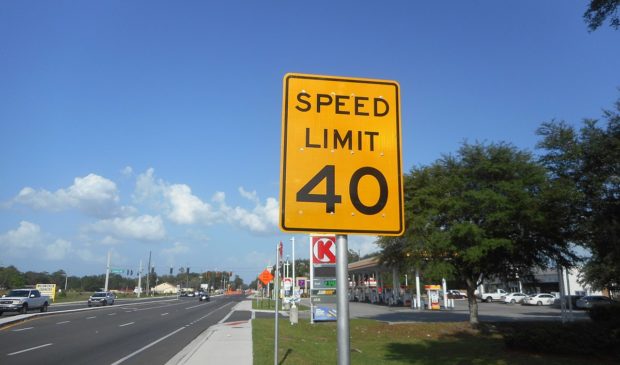Garza suggests color-coded speed zones to slow car traffic
Monday, June 1, 2020 by
Ryan Thornton At least in the short term, the Austin Transportation Department is hanging its hopes of reducing traffic fatalities and serious injuries on a proposal that would drop most downtown and residential streets to a 25 mph speed limit while coordinating with the Austin Police Department to educate residents and enforce those reductions.
The concept earned the unanimous support of the Urban Transportation Commission last month as well as an early endorsement from Council Member Ann Kitchen at Thursday’s meeting of the Mobility Committee. However, Mayor Pro Tem Delia Garza requested that the department also consider the visual cues that influence driver behavior as part of the comprehensive revision going to City Council for a vote June 11.
Physical and visual cues can be considered part of a street’s design, along with factors like street width and surface material that influence a driver’s preferred speed on a roadway.
“There’s a little back and forth with what needs to come first – engineering treatments or the posted speeds – and as we’ve said it’s part of a safe systems approach to do all of it, but we know we can’t get to 320 square miles of Austin’s geographic boundaries with engineering treatments anytime soon,” Lewis Leff, transportation safety officer at Austin Transportation, said in a phone call Friday.
Inspired by an educational trip to the Netherlands last fall, Garza explained that the country follows consistent design principles that inform motorists what type of streets they are entering and how fast they are expected to travel. But noting the prohibitive cost of adapting Austin’s street network to match the Dutch standards, she suggested the department could use simpler visual cues, like color markings on speed limit signs, as subconscious reminders for all road users.
As an example of such a scheme, Garza said streets that are set at 25 mph could be marked with strips of blue, whether on the speed limit sign or on parts of the street or curb. Using colors from the department’s proposal map, every speed from 25 mph to 50 mph would correlate with a distinct color. Even in the absence of safer street designs, Garza said relatively recent studies have shown that road markings alone can increase compliance with speed limits.
Although Austin Transportation acknowledges the need to retrofit much of the street network for lower speeds, Leff said the department has been encouraged by results seen in other cities like Boston and Seattle after making similar comprehensive speed limit changes.
Leff said Seattle was able to reduce high-end speeding (more than 10 mph above the limit) by between 45 and 65 percent, collisions by over 20 percent and injuries by 11 to 30 percent, with nothing but 25 mph speed limit signs.
“So there’s definitely value, even if we just posted the signs without the other things that we are doing with engineering treatments and public awareness efforts and the enforcement wrapped around it,” Leff said.
Eric Bollich, acting assistant director at Austin Transportation, said the department has limited flexibility to modify or add additional visual cues to signs under the state’s Manual on Uniform Traffic Control Devices. When appropriate, he said the department can make signs larger or add more in a certain area, create special notice signs, or decorate signs with flags, red borders, flashing beacons, or reflective materials. Regarding a color-coded speed zone program, however, Bollich told the Austin Monitor the department would have to evaluate its options under local and state policy.
Between dealing with the complexities of state sign regulations and improving street design, Billy Fields, a Texas State University professor who has conducted extensive research on street design in Holland, said there is more flexibility to simply fix the streets, even if it means painting sidewalks in places where there is no funding for new concrete.
Fields said the city needs a residential streets program like that in Holland, which has created a network of 18 mph streets that feature a series of standard design cues – a brick surface and speed humps, among other characteristics – that motorists encounter upon entering and leaving the low-speed zone.
“There’s lots of great projects in Austin, but it doesn’t seem like we replicate all of them all of the time,” Fields said. “If you think about redoing all of Austin’s streets, you’re not going to be able to do that in one fell swoop, but we go through and we resurface the streets all the time. Each time that we resurface a street we should be looking for those opportunities.”
Leff, however, said a main benefit of the new speed modifications is its consistency across the city, allowing road users to habituate to the new standards.
“We can go out and put signs and we can do all sorts of things, but really at this point moving forward with this recommendation, if somebody is on a street that has a bunch of houses on it, they should know it’s likely 25 mph,” he said. “If they are in an area that there’s a lot of activity, they should know that it’s likely going to be 35. So there’s just a few exceptions to the rule at this point with this recommendation.”
Photo made available through a Creative Commons license.
The Austin Monitor’s work is made possible by donations from the community. Though our reporting covers donors from time to time, we are careful to keep business and editorial efforts separate while maintaining transparency. A complete list of donors is available here, and our code of ethics is explained here.
You're a community leader
And we’re honored you look to us for serious, in-depth news. You know a strong community needs local and dedicated watchdog reporting. We’re here for you and that won’t change. Now will you take the powerful next step and support our nonprofit news organization?







